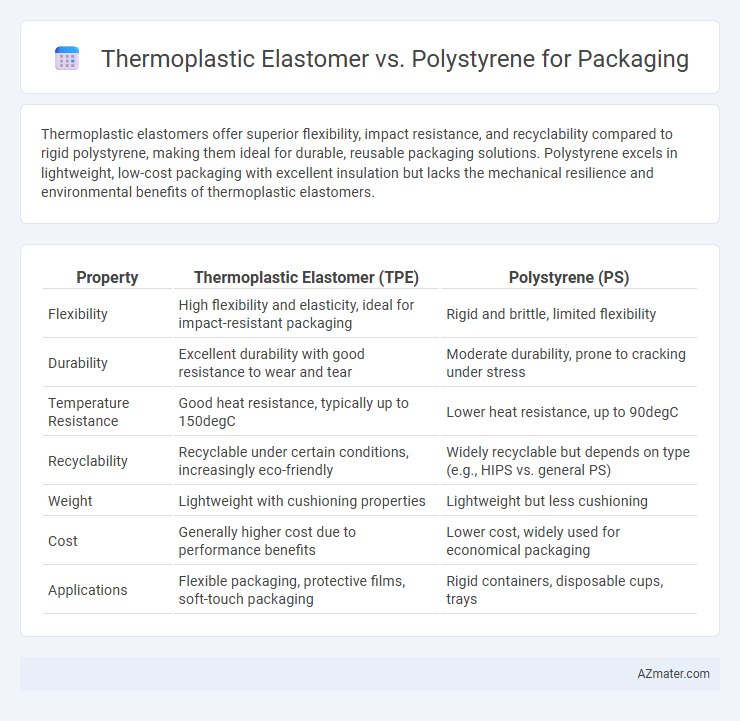Thermoplastic elastomers offer superior flexibility, impact resistance, and recyclability compared to rigid polystyrene, making them ideal for durable, reusable packaging solutions. Polystyrene excels in lightweight, low-cost packaging with excellent insulation but lacks the mechanical resilience and environmental benefits of thermoplastic elastomers.
Table of Comparison
| Property | Thermoplastic Elastomer (TPE) | Polystyrene (PS) |
|---|---|---|
| Flexibility | High flexibility and elasticity, ideal for impact-resistant packaging | Rigid and brittle, limited flexibility |
| Durability | Excellent durability with good resistance to wear and tear | Moderate durability, prone to cracking under stress |
| Temperature Resistance | Good heat resistance, typically up to 150degC | Lower heat resistance, up to 90degC |
| Recyclability | Recyclable under certain conditions, increasingly eco-friendly | Widely recyclable but depends on type (e.g., HIPS vs. general PS) |
| Weight | Lightweight with cushioning properties | Lightweight but less cushioning |
| Cost | Generally higher cost due to performance benefits | Lower cost, widely used for economical packaging |
| Applications | Flexible packaging, protective films, soft-touch packaging | Rigid containers, disposable cups, trays |
Introduction to Packaging Materials
Thermoplastic elastomers (TPE) offer flexibility, durability, and recyclability, making them ideal for packaging requiring elasticity and impact resistance. Polystyrene (PS), known for its rigidity, low cost, and clarity, is commonly used in protective packaging and disposable containers. Choosing between TPE and PS depends on the packaging's functional demands, such as strength, flexibility, and environmental considerations.
What Are Thermoplastic Elastomers (TPE)?
Thermoplastic elastomers (TPE) are a class of polymers combining the properties of rubber with the recyclability and processing advantages of plastics, making them ideal for flexible and durable packaging applications. Unlike polystyrene, which is rigid and brittle, TPEs provide excellent elasticity, impact resistance, and versatility in molding processes, enhancing protective packaging solutions. Key TPE materials include styrenic block copolymers, thermoplastic polyolefins, and thermoplastic polyurethanes, which contribute to cushioning, shock absorption, and reusability in packaging designs.
Overview of Polystyrene in Packaging
Polystyrene is a versatile thermoplastic widely used in packaging due to its rigidity, clarity, and cost-effectiveness. Its excellent insulating properties make it ideal for food containers, disposable cutlery, and protective packaging materials such as foam peanuts and cushioning trays. Despite its benefits, polystyrene's limited impact resistance and environmental concerns have driven demand for more sustainable alternatives like thermoplastic elastomers.
Mechanical Properties: TPE vs. Polystyrene
Thermoplastic elastomers (TPE) exhibit superior flexibility and impact resistance compared to the rigid and brittle nature of polystyrene, making TPE ideal for packaging applications requiring durability and shock absorption. Polystyrene's high stiffness and low elongation at break provide excellent structural integrity but limited resilience under mechanical stress. TPE's enhanced elongation and tensile strength enable repeated deformation without cracking, offering improved performance in dynamic packaging environments.
Flexibility and Durability Comparison
Thermoplastic elastomers (TPE) offer superior flexibility compared to polystyrene, making them ideal for packaging applications requiring repeated bending or stretching without cracking. TPE materials demonstrate enhanced durability by resisting impact and fatigue better than the rigid, brittle nature of polystyrene, which tends to fracture under stress. The resilience of thermoplastic elastomers extends the lifespan of packaging, providing better protection during transportation and handling.
Environmental Impact and Sustainability
Thermoplastic elastomers (TPEs) offer superior environmental performance compared to polystyrene (PS) due to their recyclability and reduced energy consumption during processing, contributing to lower carbon emissions. TPEs are often derived from sustainable sources and can be reprocessed multiple times without significant degradation, whereas polystyrene is typically non-biodegradable and challenging to recycle, leading to increased landfill waste and environmental pollution. The use of TPE in packaging aligns with circular economy principles by facilitating material recovery and reducing reliance on fossil fuel-derived plastics.
Cost Analysis and Market Trends
Thermoplastic elastomers (TPE) generally offer higher upfront costs compared to polystyrene (PS) but provide enhanced durability and flexibility that reduce long-term packaging expenses. Polystyrene remains dominant in cost-sensitive packaging markets due to its low material and processing costs despite environmental concerns impacting demand. Market trends indicate a growing shift towards TPEs driven by increasing regulations and consumer preference for sustainable, reusable packaging solutions.
Safety and Compliance Considerations
Thermoplastic elastomers (TPE) offer superior safety advantages in packaging applications due to their flexibility, chemical resistance, and compliance with FDA and EU food-grade standards, minimizing risks of contamination and toxic leachates. Polystyrene (PS), commonly used in rigid packaging, poses challenges with potential styrene migration, necessitating stringent regulatory monitoring under agencies like the FDA and EFSA to ensure consumer safety. Compliance with industry-specific standards such as REACH and RoHS is critical when selecting TPE or PS materials to meet environmental regulations and safe direct food contact requirements.
Industry Applications: Where Each Excels
Thermoplastic elastomers (TPEs) excel in flexible packaging applications such as squeezable tubes, resealable bags, and flexible film wraps due to their excellent elasticity, chemical resistance, and durability. Polystyrene (PS) is preferred in rigid packaging solutions like food containers, disposable cutlery, and CD cases because of its high rigidity, clarity, and cost-effectiveness. Industries such as food and beverage packaging leverage TPEs for customizable, durable seals whereas consumer electronics packaging often relies on polystyrene for protective casings and display packaging.
Choosing the Right Material for Your Packaging Needs
Thermoplastic elastomers (TPE) offer superior flexibility, impact resistance, and recyclability, making them ideal for packaging that requires durability and shock absorption. Polystyrene (PS) excels in rigidity, clarity, and cost-effectiveness, suitable for lightweight, transparent packaging such as food containers and disposable cutlery. Evaluating factors like product protection, cost constraints, and environmental impact helps determine the optimal choice between TPE and Polystyrene for specific packaging applications.

Infographic: Thermoplastic elastomer vs Polystyrene for Packaging
 azmater.com
azmater.com